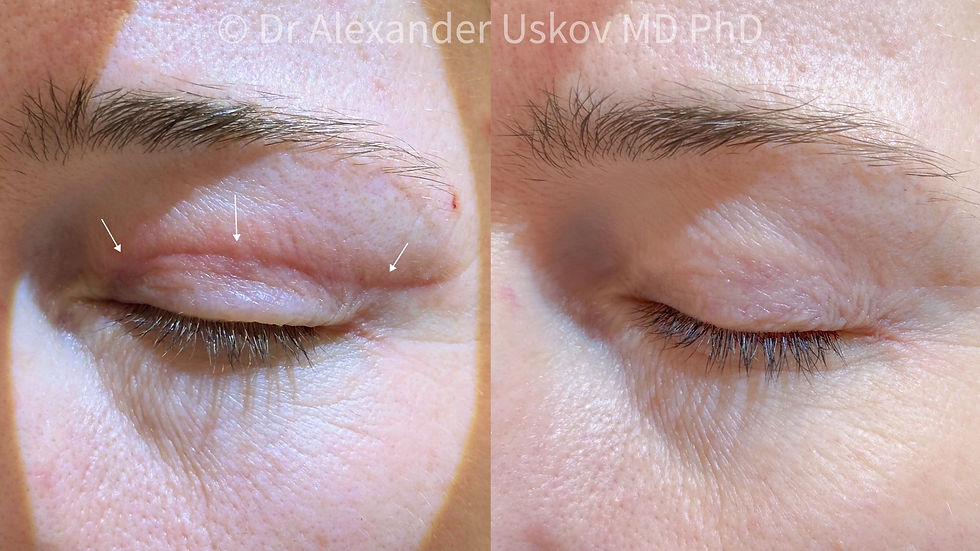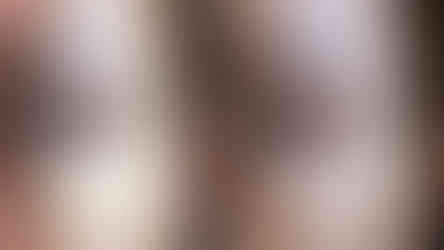Laser removal of scars after upper blepharoplasty
- gertnulk
- Aug 17
- 3 min read
Updated: Oct 22
Safe restoration of eyelid aesthetics after surgery — at the clinic of international expert Dr. Uskov

Upper eyelid blepharoplasty is one of the most sought-after aesthetic procedures worldwide. However, even with perfect surgical technique, some patients may develop noticeable scars in the mobile eyelid area, causing aesthetic discomfort, asymmetry, shadows, or a visually heavy appearance.
Laser scar removal after blepharoplasty is a modern, safe, and evidence-based method that helps restore smoothness and natural skin color in the delicate eyelid area. At Dr. Uskov’s clinic, personalized protocols are applied, taking into account the phase of scar formation, skin type, and eyelid anatomy.
Why this matters
Statistics show that up to 5–10% of patients after blepharoplasty experience some healing irregularities:
pronounced hyperpigmentation along the scar line,
thickening or retraction of the skin,
formation of keloid or hypertrophic scars,
thin but highly visible light-colored lines contrasting with surrounding skin.
This is especially important for women, as the upper eyelids are central to facial expressions and attention. Even minor post-surgical defects can lead to:
decreased self-esteem,
reluctance to use makeup,
a feeling of an “unsuccessful surgery.”

When can scar removal begin?
The most effective treatment occurs during the active scar remodeling phase, 4–12 weeks after surgery, when:
the skin has already healed,
the scar is no longer an acute wound,
but the tissue has not yet matured into a dense, rigid formation.
At Dr. Uskov’s clinic, even older scars can be treated; however, these cases usually require more sessions, a combined approach, and sometimes a more intensive protocol.
Which lasers are used?
Dr. Uskov’s clinic has nearly all wavelengths used worldwide for scar treatment, including:
Fractional non-ablative lasers (Er:Glass, Er:YAG) — for gentle stimulation of remodeling;
Ablative lasers (CO₂, Er:YAG) — to correct thickened or uneven tissue;
Picosecond lasers — for hypopigmented or post-inflammatory scars;
Nd:YAG lasers — for scars with a vascular component or redness.
Each treatment protocol is individualized, considering:
location (upper eyelid),
skin thickness,
scar tissue type,
condition of surrounding skin and eyelid mobility.
Why professional expertise is essential
Scar removal in the upper eyelid area is particularly delicate and requires:
precise adjustment of power, pulse length, and penetration depth,
experience in laser work in the periocular region,
sometimes the use of scleral shields (when working near the lash line),
minimizing risks of eyelid deformation, hyperpigmentation, or tissue hypertrophy.
At Dr. Uskov’s clinic, all procedures are performed by specialists experienced in laser dermatology.
Course of treatment at Dr Uskov's clinic
In-person consultation and diagnostics:
Visual examination
If necessary:
Digital dermatoscopy
Wood’s lamp examination
Infrared scanning and 3D imaging
Ultrasound of the skin and orbital area
Treatment planning:
Determining the phase of scar development
Choosing the optimal laser technology
Discussing expected results and the number of procedures
Laser procedure:
Performed under local anesthesia if needed
Surrounding tissues remain unharmed
Eye protection is applied when required
Post-procedure care:
Prescribed creams and ointments
Sun protection recommendations
Individual schedule for follow-up visits
How many sessions are required?
2–5 sessions for fresh, soft, and shallow scars
6–8 sessions for mature, dense, retracted, or pigmented scars
Intervals between sessions: 4–12 weeks
Safety and effectiveness
We aim for:
Smooth, inconspicuous scars
Preservation of the natural eyelid anatomy
Prevention of scar recurrence
With premium medical equipment, strict protocols, and experienced specialists, we achieve natural, predictable, and aesthetically pleasing results without complications.
Individual results
Every skin type, scar, and patient is unique. That’s why at our clinic:
We provide realistic expectations rather than false guarantees
Assess the condition of your skin carefully
Show before-and-after results on real patients
Create a treatment course tailored to your individual biological characteristics
If you are concerned about a scar after blepharoplasty, don’t wait for it to “go away on its own.” Early intervention with a professional approach ensures the most aesthetic and safe outcome.
Schedule a consultation for scar removal after blepharoplasty 👉here👈
Want to know more?
Visit Dr. Uskov’s blog at scarsinfo.com for:
Articles on laser treatment of surgical scars
Postoperative skincare recommendations
Answers to frequently asked patient questions
Real patient stories and photos






















